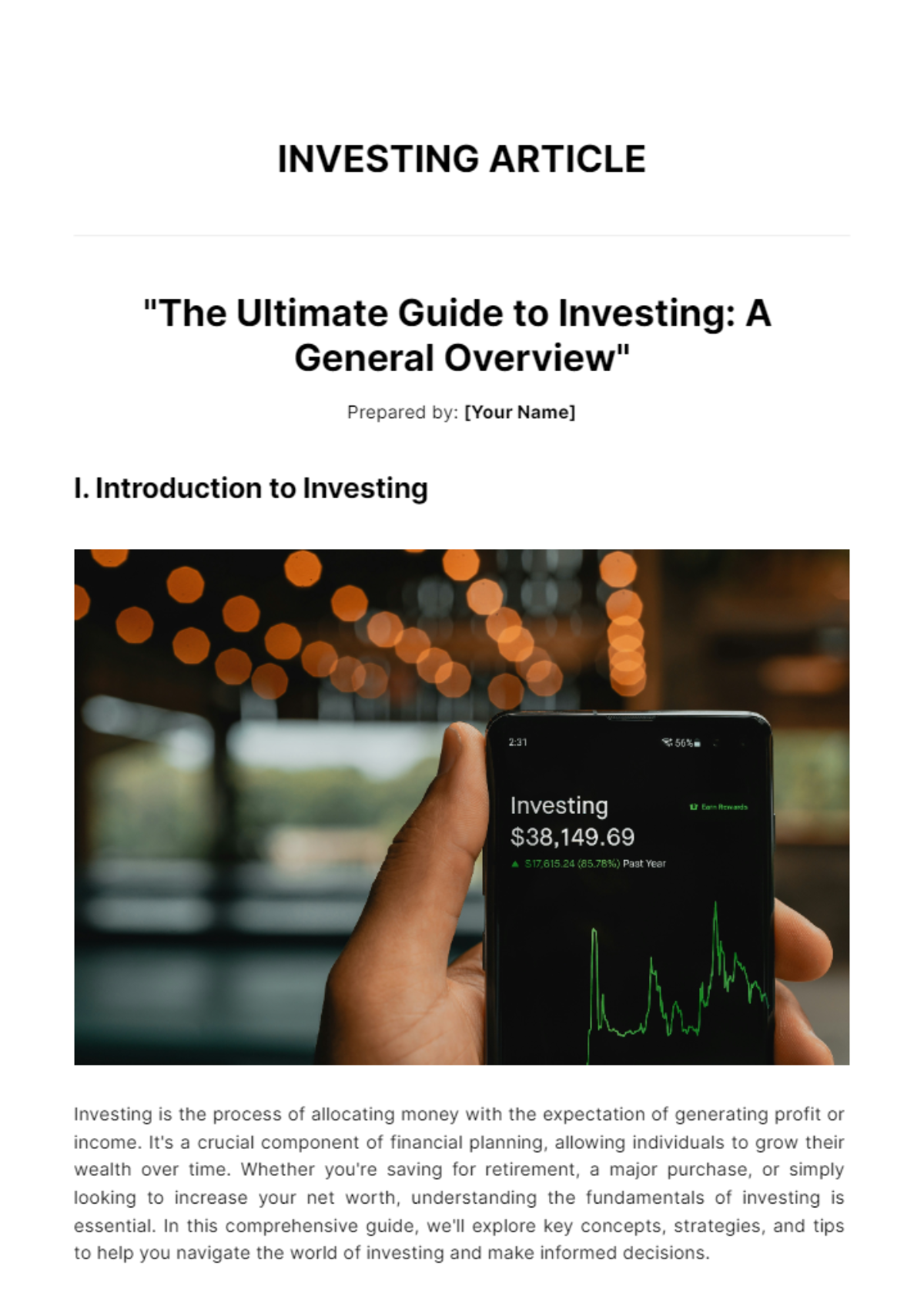Free Investing Article

INVESTING ARTICLE
"The Ultimate Guide to Investing: A General Overview"
Prepared by: [Your Name]
I. Introduction to Investing

Investing is the process of allocating money with the expectation of generating profit or income. It's a crucial component of financial planning, allowing individuals to grow their wealth over time. Whether you're saving for retirement, a major purchase, or simply looking to increase your net worth, understanding the fundamentals of investing is essential. In this comprehensive guide, we'll explore key concepts, strategies, and tips to help you navigate the world of investing and make informed decisions.
II. Why Invest?
Investing offers the potential for long-term wealth accumulation and financial security. Unlike saving, which involves setting aside money in low-risk accounts, investing involves putting your money to work in various asset classes such as stocks, bonds, real estate, and commodities. By harnessing the power of compound interest and taking advantage of market opportunities, investors can achieve higher returns than traditional savings accounts over time.
III. Setting Financial Goals
Before diving into the world of investing, it's essential to establish clear financial goals. Your investment objectives will shape your investment strategy and help you stay focused on your long-term vision. Whether you're aiming to build a retirement nest egg, save for your children's education, or achieve financial independence, having specific goals will guide your investment decisions. Consider factors such as your time horizon, risk tolerance, and desired rate of return when setting your goals.
IV. Types of Investments
When it comes to investing, there are various asset classes to consider, each with its own risk and return characteristics. Common types of investments include:
Stocks: Ownership shares in publicly-traded companies, offering the potential for capital appreciation and dividends.
Bonds: Debt securities issued by governments or corporations, providing regular interest payments and return of principal at maturity.
Mutual Funds: Pooled funds that invest in a diversified portfolio of stocks, bonds, or other assets, offering diversification and professional management.
Exchange-Traded Funds (ETFs): Similar to mutual funds but traded on stock exchanges like individual stocks, offering flexibility and low expense ratios.
Real Estate: Investing in physical properties or real estate investment trusts (REITs), offering potential rental income and capital appreciation.
Commodities: Investing in tangible goods such as gold, oil, or agricultural products, offering diversification and inflation protection.
V. Assessing Risk Tolerance

Understanding your risk tolerance is crucial in determining the appropriate investment strategy for your financial goals. Risk tolerance refers to your ability and willingness to endure fluctuations in the value of your investments. Factors such as age, investment timeframe, and financial obligations influence your risk tolerance. It's essential to strike a balance between risk and reward that aligns with your comfort level.
VI. Creating a Diversified Portfolio
Diversification is a cornerstone of successful investing, helping to mitigate risk and maximize returns. By spreading your investments across various asset classes, industries, and geographic regions, you can reduce the impact of market volatility on your portfolio. Consideration should be given to factors such as asset allocation, investment style, and rebalancing to maintain a diversified portfolio.
VII. Implementing an Investment Strategy

Once you've defined your financial goals, assessed your risk tolerance, and created a diversified portfolio, it's time to implement your investment strategy. Whether you prefer a hands-on approach or enlist the help of a financial advisor, regularly monitoring your investments and adjusting your strategy as needed is essential for long-term success. Stay informed about market trends, economic indicators, and legislative changes that may impact your investments.
Expert Tip: Emotional investing often leads to underperformance. Stick to your investment plan despite market volatility for better long-term results.
VIII. Conclusion
Investing is a journey that requires patience, discipline, and a long-term perspective. By understanding the fundamentals of investing, setting clear financial goals, and implementing a diversified investment strategy, you can work towards achieving your financial objectives and building wealth over time. Remember to stay informed, stay focused, and stay committed to your investment plan for a brighter financial future.
- 100% Customizable, free editor
- Access 1 Million+ Templates, photo’s & graphics
- Download or share as a template
- Click and replace photos, graphics, text, backgrounds
- Resize, crop, AI write & more
- Access advanced editor
Discover the ultimate Investing Article Template on Template.net! Crafted by experts, this editable and customizable template is tailored for finance enthusiasts. Seamlessly adjust content in our Ai Editor Tool to suit your needs. Unlock the power of precise investment guidance with ease and efficiency. Get started today!





























